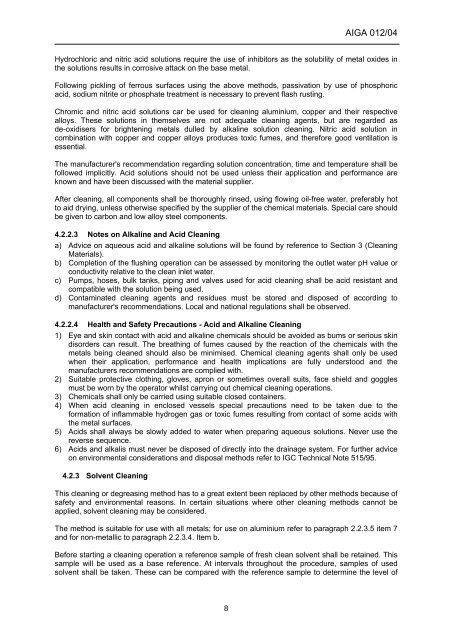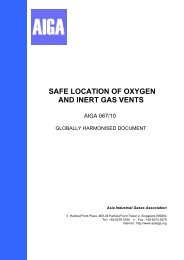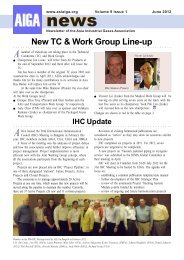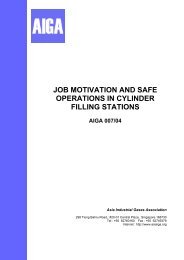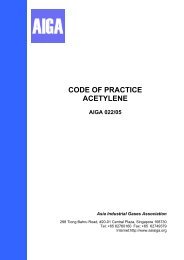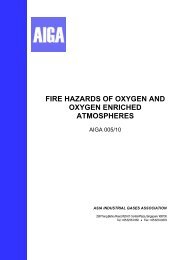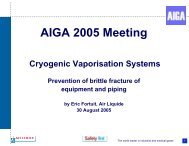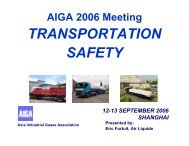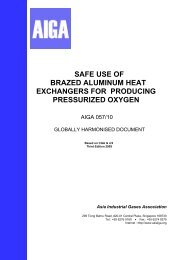CLEANING OF EQUIPMENT FOR OXYGEN SERVICE - AIGA
CLEANING OF EQUIPMENT FOR OXYGEN SERVICE - AIGA
CLEANING OF EQUIPMENT FOR OXYGEN SERVICE - AIGA
Create successful ePaper yourself
Turn your PDF publications into a flip-book with our unique Google optimized e-Paper software.
8<br />
<strong>AIGA</strong> 012/04<br />
Hydrochloric and nitric acid solutions require the use of inhibitors as the solubility of metal oxides in<br />
the solutions results in corrosive attack on the base metal.<br />
Following pickling of ferrous surfaces using the above methods, passivation by use of phosphoric<br />
acid, sodium nitrite or phosphate treatment is necessary to prevent flash rusting.<br />
Chromic and nitric acid solutions car be used for cleaning aluminium, copper and their respective<br />
alloys. These solutions in themselves are not adequate cleaning agents, but are regarded as<br />
de-oxidisers for brightening metals dulled by alkaline solution cleaning. Nitric acid solution in<br />
combination with copper and copper alloys produces toxic fumes, and therefore good ventilation is<br />
essential.<br />
The manufacturer's recommendation regarding solution concentration, time and temperature shall be<br />
followed implicitly. Acid solutions should not be used unless their application and performance are<br />
known and have been discussed with the material supplier.<br />
After cleaning, all components shall be thoroughly rinsed, using flowing oil-free water, preferably hot<br />
to aid drying, unless otherwise specified by the supplier of the chemical materials. Special care should<br />
be given to carbon and low alloy steel components.<br />
4.2.2.3 Notes on Alkaline and Acid Cleaning<br />
a) Advice on aqueous acid and alkaline solutions will be found by reference to Section 3 (Cleaning<br />
Materials).<br />
b) Completion of the flushing operation can be assessed by monitoring the outlet water pH value or<br />
conductivity relative to the clean inlet water.<br />
c) Pumps, hoses, bulk tanks, piping and valves used for acid cleaning shall be acid resistant and<br />
compatible with the solution being used.<br />
d) Contaminated cleaning agents and residues must be stored and disposed of according to<br />
manufacturer's recommendations. Local and national regulations shall be observed.<br />
4.2.2.4 Health and Safety Precautions - Acid and Alkaline Cleaning<br />
1) Eye and skin contact with acid and alkaline chemicals should be avoided as bums or serious skin<br />
disorders can result. The breathing of fumes caused by the reaction of the chemicals with the<br />
metals being cleaned should also be minimised. Chemical cleaning agents shall only be used<br />
when their application, performance and health implications are fully understood and the<br />
manufacturers recommendations are complied with.<br />
2) Suitable protective clothing, gloves, apron or sometimes overall suits, face shield and goggles<br />
must be worn by the operator whilst carrying out chemical cleaning operations.<br />
3) Chemicals shall only be carried using suitable closed containers.<br />
4) When acid cleaning in enclosed vessels special precautions need to be taken due to the<br />
formation of inflammable hydrogen gas or toxic fumes resulting from contact of some acids with<br />
the metal surfaces.<br />
5) Acids shall always be slowly added to water when preparing aqueous solutions. Never use the<br />
reverse sequence.<br />
6) Acids and alkalis must never be disposed of directly into the drainage system. For further advice<br />
on environmental considerations and disposal methods refer to IGC Technical Note 515/95.<br />
4.2.3 Solvent Cleaning<br />
This cleaning or degreasing method has to a great extent been replaced by other methods because of<br />
safety and environmental reasons. In certain situations where other cleaning methods cannot be<br />
applied, solvent cleaning may be considered.<br />
The method is suitable for use with all metals; for use on aluminium refer to paragraph 2.2.3.5 item 7<br />
and for non-metallic to paragraph 2.2.3.4. Item b.<br />
Before starting a cleaning operation a reference sample of fresh clean solvent shall be retained. This<br />
sample will be used as a base reference. At intervals throughout the procedure, samples of used<br />
solvent shall be taken. These can be compared with the reference sample to determine the level of


